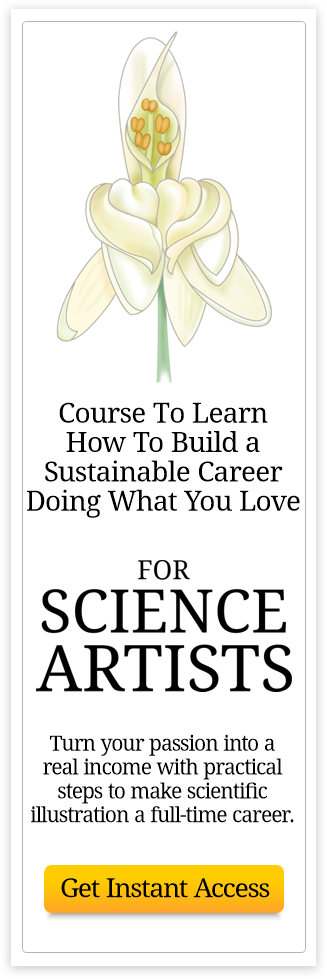
How Well Do You Know Your Audience?
Last time, we talked about how well your audience knows you—but today, we’re flipping the script. How well do you know the scientists, researchers, and professionals who could benefit from your scientific illustration services?
As scientific illustrator, understanding the needs, motivations, and challenges of your potential clients is key to making sure your work resonates and attracts the right kind of attention.

Why Understanding Your Audience is Key
As scientific illustrators, our work is specialized, but that means our audience is too. Scientists and researchers are often looking for more than just beautiful illustrations.
They need visuals that clearly communicate complex data and ideas. If you don’t understand their specific needs, it’s much harder to show them how your services can help.
For example, scientists frequently face challenges when it comes to data visualization or communicating their findings to non-expert audiences.
Knowing these pain points allows you to offer tailored solutions, like creating clear, accurate visuals that make their research accessible and impactful.
When you understand what they’re struggling with, you can position your services as the perfect answer to their problems.
When you understand your audience deeply, you're able to tailor your messaging to fit their needs, speak their language, and position your services as the solution to their problems.
This is especially important in specialized fields like scientific illustration, where potential clients may not even realize how much they need your expertise.
Understanding Clients Leads to Better Promotion
Effective marketing isn’t just about getting your work out there; it’s about making sure your message connects with the right people.
This is why understanding your audience deeply is crucial. When you know what scientists care about, you can speak their language and connect with their goals.
Scientists value precision, clarity, and the ability to communicate their research effectively. When your marketing reflects these values, you’re far more likely to catch their attention. Instead of generic messages, you can create marketing materials that directly address their needs.
To do this, you need to know what makes your potential clients tick. So, how do you get to know your audience? Here are a few simple strategies:
- Conduct Research:
Take the time to dig into the industries and sectors you want to work with. What are their biggest challenges? What solutions are they looking for?
Reading scientific papers, attending conferences, or even joining online communities like forums and social media groups can give you insight into what scientists care about and how you can position your services to meet their needs.

- Ask Questions:
Don't hesitate to ask your current clients what they need most from an illustrator. What challenges do they face when it comes to visual communication? How can you make their work easier? You can also conduct surveys to gather more formal feedback from a broader range of potential clients.
- Observe Trends:
Keep an eye on trends within the scientific community. For example, are more researchers looking for ways to communicate their findings to non-scientists?
Are there new technologies or methods emerging in fields like biotechnology or ecology that require specific types of visuals? By staying informed, you can tailor your portfolio to highlight the exact type of work these professionals need.
By doing this kind of homework, you’ll understand the pain points your clients face. This deeper understanding will let you adjust your marketing messages accordingly and will lead to better engagement. Instead of generic offers, your marketing will speak directly to their needs.
When your services align with what your potential clients are looking for, you’ll get more inquiries, better leads, and more projects with satisfied clients.
Strengthening Client Relationships
Knowing your audience isn’t just about getting the project—it’s also about building strong, lasting relationships. Scientists appreciate collaborators who understand the nuances of their work and can provide solutions tailored to their research needs.
When you’re able to meet their expectations—or better yet, exceed them—you’re not just completing a project, you’re establishing trust.
Think of it this way: A medical researcher looking to explain a complex surgical procedure to patients will be more interested in how your illustrations can simplify and clarify important medical information, rather than just the artistic quality of your work. If you don’t emphasize your ability to communicate these kinds of concepts, you might be overlooked.
As you begin to understand what motivates your clients—whether it's presenting research, securing funding, or communicating with the public—you can tailor your services and your marketing to hit those exact points. This is where your knowledge of your audience becomes invaluable.
This kind of deep understanding fosters long-term client relationships, meaning repeat business and referrals.
What’s Coming Next: Get Ready for a Special Report!
By now, you can see how important it is to truly know your audience if you want to attract the right clients and create long-lasting relationships. But there’s even more you can learn!
In the next issue of our newsletter, we’ll be giving away a special report that dives even deeper into understanding your clients.
This report, "Scientist’s Mind: Understand Your Clients to Elevate Your Services," is packed with insights into the minds of scientists and researchers.

It will help you learn what drives them, what they need most, and how you can tailor your services to match those needs perfectly. You won’t want to miss it—so make sure you’re subscribed to our newsletter!
LIKE THIS ARTICLE?
YOU'LL 🧡 THE NEWSLETTER!
Get timely tips to improve your services, land more projects, illustration tips, and more...

